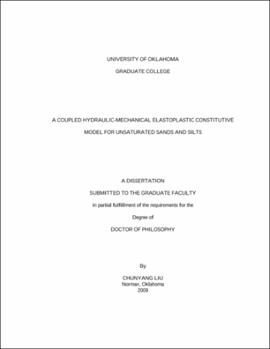| dc.contributor.advisor | Muraleetharan, Kanthasamy | |
| dc.creator | LIU, CHUNYANG | |
| dc.date.accessioned | 2019-04-27T21:28:09Z | |
| dc.date.available | 2019-04-27T21:28:09Z | |
| dc.date.issued | 2009 | |
| dc.identifier | 99213079902042 | |
| dc.identifier.uri | https://hdl.handle.net/11244/318754 | |
| dc.description.abstract | Unsaturated soils are three-phase porous media consisting of a solid skeleton, pore water, and pore air. It is well known that the behavior of unsaturated soils is influenced heavily by the matric suction (pore air pressure minus pore water pressure). Soil water characteristic curves (SWCCs) describe the relationship between matric suction and water content in unsaturated soils. In terms of constitutive modeling of soils, the relationship between matric suction and water content can be termed the hydraulic behavior of soils. SWCCs show hysteretic behavior depending on wetting/drying history of the soil. Recently geotechnical engineers have begun to notice that SWCCs also depend on the stress-strain history (mechanical behavior) of a soil. The hydraulic behavior of unsaturated soils, on the other hand, influences the mechanical behavior through matric suction. All of these facts, especially the coupling effects between hydraulic and mechanical behavior, demonstrate a very complex behavior of unsaturated soils. | |
| dc.description.abstract | Unsaturated soils are prevalent in many parts of the world and geotechnical engineers are often called to predict the behavior of these structures such as the rainfall induced failure of a compacted soil slope. In order to predict the behavior of unsaturated soil geotechnical engineering structures, a hysteretic SWCCs model is first proposed based on the bounding surface plasticity concept. The hysteresis in SWCCs is modeled using concepts that parallel the elastoplastic theory used to model stress-strain behavior of soils. Matric suction is used as the stress variable and volume fraction of water or volumetric water content is used as the strain variable in modeling the SWCCs. This hysteretic SWCCs model is incorporated into a simple isotropic constitutive model to verify the proposed concepts that account for the coupling effects between hydraulic and mechanical behavior of unsaturated soils. Then a comprehensive constitutive model for unsaturated soils is developed in the general stress space. The rate equations of the proposed unsaturated soil model are integrated using a fully implicit integration scheme. Two sets of laboratory tests, one for Minco silt and another for Toyoura sand are used to calibrate and validate the model performance. The model is shown to capture the influence of stress-strain history on the SWCCs and the influence of SWCCs on the stress-strain behavior of silts and sands and predict the laboratory tests reasonably well. | |
| dc.format.extent | 249 pages | |
| dc.format.medium | application.pdf | |
| dc.language | en_US | |
| dc.relation.requires | Adobe Acrobat Reader | |
| dc.subject | Soil mechanics | |
| dc.subject | Soil moisture | |
| dc.subject | Elastoplasticity--Mathematical models | |
| dc.title | A COUPLED HYDRAULIC-MECHANICAL ELASTOPLASTIC CONSTITUTIVE MODEL FOR UNSATURATED SANDS AND SILTS | |
| dc.type | text | |
| dc.type | document | |
| dc.thesis.degree | Ph.D. | |
| ou.group | College of Engineering::School of Civil Engineering and Environmental Science | |
